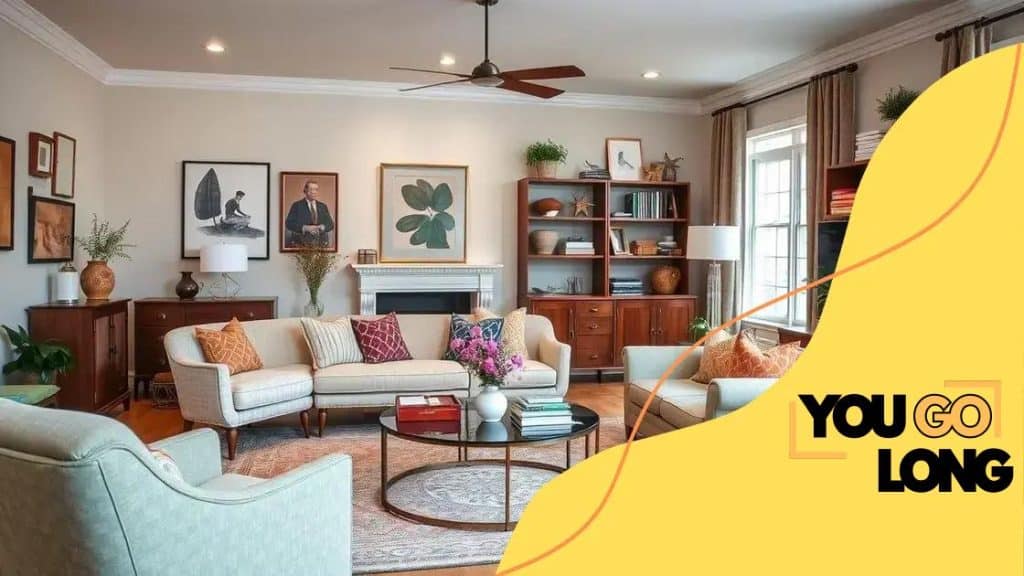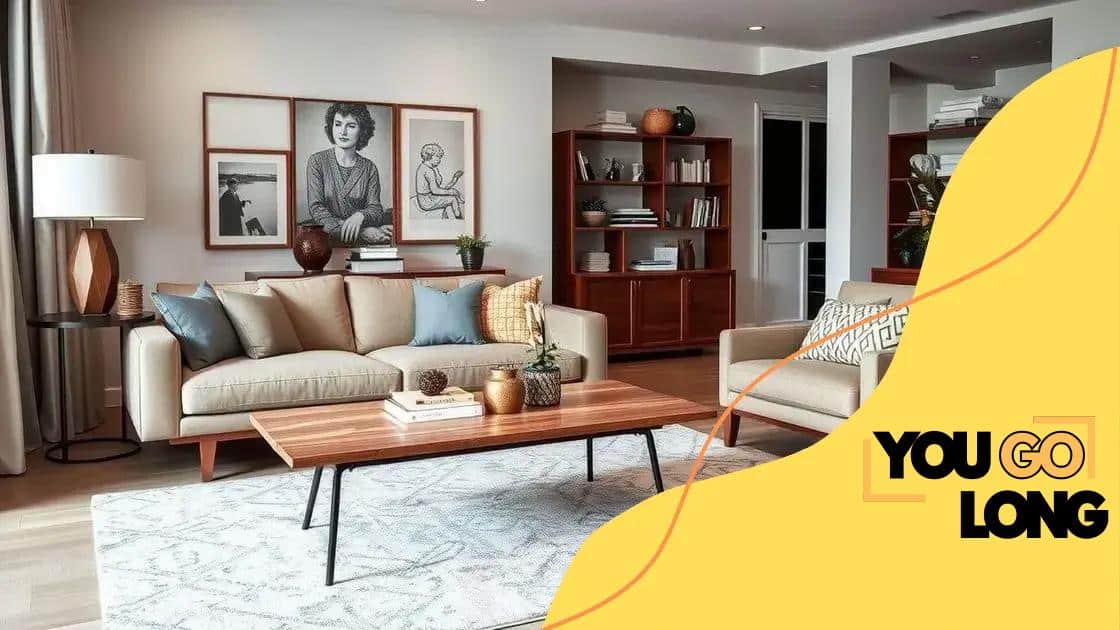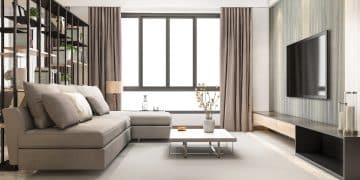How to blend different decor styles to create harmony

Advertisement
To blend different decor styles and create harmony, choose a primary style, select a complementary color palette, incorporate textures, and personalize your space with unique, meaningful items.
Creating harmony in your home can seem tricky, especially when blending different decor styles. But don’t worry! How to blend different decor styles to create harmony is not only achievable, but it can also turn your space into a reflection of your personality. Let’s explore how this can transform your living environment.
Understanding the basics of decor styles
Understanding the basics of decor styles is essential when you want to create a harmonious space. Knowing the different styles allows you to mix and match effectively. As you explore these styles, remember that each one has its unique characteristics and atmosphere.
Common Decor Styles
Here are some popular decor styles to consider when designing your space:
Advertisement
- Modern: Features clean lines, minimalism, and a neutral color palette.
- Traditional: Focuses on elegance, symmetry, and rich colors, often with classic furniture.
- Bohemian: Emphasizes artistic freedom with vibrant colors, eclectic furnishings, and layered textiles.
- Industrial: Incorporates raw materials like metal and wood, showcasing a rustic charm.
To blend these styles, choose a base style that fits your vision. Then, add elements from other styles that complement the primary choice. For example, pairing modern furniture with bohemian textiles can create a stunning and functional space.
Choosing a Focal Point
A key aspect of blending styles is establishing a focal point. This could be a piece of art, furniture, or a unique accessory. Make sure the focal point reflects your central style while harmonizing with the other elements. Adding various textures from different styles promotes visual interest.
Light fixtures are another excellent way to bridge styles. A modern chandelier can complement a traditional dining table, striking a balance between different aesthetics. Always keep in mind the color palette you’ve chosen, ensuring the hues resonate across all styles you incorporate.
Advertisement
Experimenting with decor styles can be rewarding. Try arranging decor items of different styles in various configurations to find what works best in your space. Don’t hesitate to mix elements; the goal is to create a cohesive look that feels uniquely yours.
Choosing a color palette for harmony
Choosing a color palette for harmony is vital in achieving a balanced and inviting space. Colors influence mood and can either unite or clash different decor styles. By carefully selecting your colors, you can enhance each element in your room.
The Basics of Color Theory
Understanding color theory helps when selecting your palette. Consider the following:
- Complementary colors: These are colors opposite each other on the color wheel. They create high contrast and energy.
- Analogous colors: These are colors next to each other on the wheel. They usually match well and create serene designs.
- Mono-chromatic colors: This palette involves variations of the same color. It adds depth without overwhelming the space.
When you choose your color palette, think about the atmosphere you want to create. Warm colors like reds and oranges can energize a room, while cool colors like blues and greens promote calmness.
Creating a Cohesive Palette
To create a cohesive palette, start by selecting a base color. This should align with the primary style of your space. From there, add 2-3 additional colors to complement and enhance the base. Incorporating neutrals can help balance bold colors and give your space more flexibility. Once you have your base, choose accent colors that reflect your personality.
For example, if your base color is a soft grey, consider adding a deep navy as an accent. This can anchor the design while adding depth. Don’t shy away from experimenting with textures and fabrics. Different materials can affect how colors appear in your space, so it’s essential to test swatches in various lighting.
Ultimately, a well-chosen color palette can tie together all the decor elements in your space, creating a visually appealing and harmonious home.
Combining modern and vintage elements

Combining modern and vintage elements can create a captivating and unique space. This blend allows you to showcase your personality while bringing a sense of history into your home. The key is to find balance between the sleekness of modern design and the character of vintage pieces.
Identifying Key Pieces
When combining styles, start by identifying key pieces from each era:
- Modern furniture: Look for sleek lines and minimalism. Think of contemporary sofas or coffee tables.
- Vintage accents: Incorporate items like antique lamps or heirloom pieces. These add warmth and a story.
- Textures and Materials: Modern styles often feature materials like metal and glass. Vintage items can bring in wood, fabric, or even ceramics, enriching the variety in your space.
These key elements should complement each other rather than compete for attention. For example, placing a vintage wooden side table next to a modern metal chair creates an interesting contrast.
Creating Harmony
To create harmony between modern and vintage, focus on a cohesive color palette. Use similar colors across different styles to tie them together. For instance, you might have a modern grey sofa paired with a vintage chair upholstered in a fabric that shares similar tones. Another approach is to use patterns and textures that resonate with both styles without overwhelming the space.
Don’t be afraid to experiment. Sometimes, unexpected combinations can work beautifully. For instance, pairing a classic Persian rug with a modern sectional can bring life and energy to your room. Remember to consider scale; large vintage items may need to be balanced with more streamlined modern pieces to avoid clutter.
The essential part of combining modern and vintage elements is to ensure each piece enhances the overall aesthetic rather than competing with it. This approach allows for a harmonious and engaging space that reflects your unique taste.
Incorporating textures and patterns
Incorporating textures and patterns can elevate your decor and create visual interest in any room. Different materials and designs enhance the experience of your space, making it feel dynamic and inviting. By mixing various textures and patterns, you can add depth and richness to your overall aesthetic.
Understanding Textures
Textures can greatly affect the feel of your space. Here are some common textures to consider:
- Soft textiles: Fabrics like velvet, cotton, and linens add warmth and comfort. Cushions, throws, and rugs can soften a room.
- Hard surfaces: Materials like wood, metal, and glass provide contrast. They can lend a modern edge to your decor.
- Natural elements: Plants and stones introduce organic textures that breathe life into your room.
When selecting textures, consider not only the visual aspect but also how they feel. For example, a plush sofa paired with a sleek glass coffee table creates an engaging contrast.
Playing with Patterns
Patterns can add excitement and character to your decor. Different types can be mixed together for an eye-catching effect:
- Geometric patterns: Clean lines and shapes can modernize your design.
- Floral patterns: These add a touch of elegance and softness.
- Stripes and plaids: They offer classic appeal and can unify different styles.
The key to successfully incorporating patterns is to balance them with solid colors and textures. You might choose a patterned rug and pair it with a solid sofa to prevent visual overload.
Incorporating textures and patterns into your decor invites depth and intrigue. Mix and match to find what resonates with you. Remember, there’s no strict rule; the goal is to create a space that reflects your unique style. Experimenting with various combinations will help you discover what works best for your home.
Personalizing your space with unique touches
Personalizing your space with unique touches allows you to express your individuality and create a home that feels truly yours. It’s about integrating items and designs that reflect your taste and story, making your space more inviting and comfortable.
Showcasing Personal Items
Start by showcasing personal items that have meaning to you. Here are some ideas to consider:
- Art and Photography: Hang your favorite artwork or family photos. This adds a sentimental touch to the room.
- Travel Souvenirs: Display souvenirs from your travels. These pieces can spark conversation and bring back fond memories.
- Personal Collections: Whether it’s books, ceramics, or vintage finds, personal collections can serve as stylish decor.
Integrating these items creates a narrative within your space, allowing visitors to learn more about you through your decor.
Choosing Custom Decor
Another way to personalize your space is by choosing custom decor. Options include:
- Custom Art: Commission a piece of art that resonates with you.
- Personalized Textiles: Consider custom pillows or blankets with unique patterns or colors.
- Tailored Furniture: Invest in furniture that meets your specific needs and style preferences.
Custom decor not only enhances the aesthetics but also adds a personal touch that store-bought items often lack. It can turn your home into a unique reflection of who you are.
When personalizing your space, remember to balance unique touches with the overall decor. Too many eclectic items can create chaos, while thoughtful placement of special pieces can enhance harmony. Think about how each object interacts with the surrounding decor, color palette, and layout.
Ultimately, personalizing your space with unique touches is all about creating a place where you feel completely at ease. This reflection of your personality will make your home inviting and comforting to both you and your guests.
In summary, blending different decor styles can create a harmonious and inviting space that reflects your personality. By understanding various styles, choosing complementary colors, and incorporating unique textures and personal items, you can achieve a beautiful and cohesive design. Remember, the key is to experiment and have fun with the process. Your home should be a true representation of who you are, making it a place where you feel comfortable and inspired.
FAQ – Frequently Asked Questions about Blending Decor Styles
How can I start blending different decor styles in my home?
Begin by selecting a primary style that resonates with you, then incorporate elements from other styles that complement it for a cohesive look.
What are some tips for choosing a color palette?
Choose a color palette that includes complementary colors, and consider using neutrals to balance bold tones for a harmonious design.
How do I incorporate personal items into my decor?
Display meaningful personal items like artwork, travel souvenirs, or collections to create a unique narrative in your space.
What textures should I consider for a well-rounded design?
Mix soft textiles like velvet with hard surfaces like wood or glass to add depth and interest to your decor.





